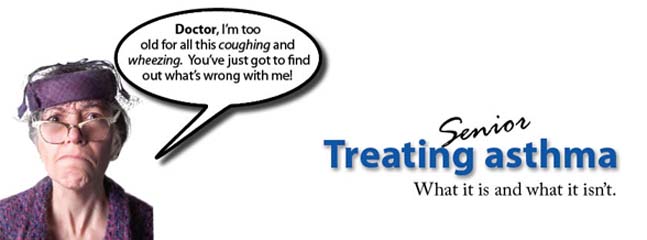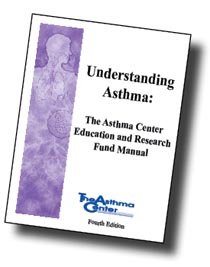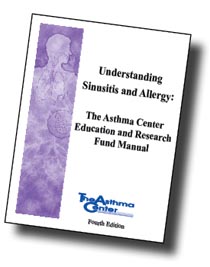Senior asthma

The elderly suffer from asthma just as frequently as young adults. Symptoms often begin slowly as a persistent cough and intermittent shortness of breath and often worsen over time. In fact, more than two million asthma patients are currently over age 65.
Over the past 10 years, clinical research has indicated that asthma in the elderly is generally under-diagnosed and under-treated, leading to a diminished quality of life and higher morbidity and mortality than those without asthma.
The differential diagnosis should include other diseases with asthma-like symptoms such as aspiration syndromes, GE reflux disease, cardiac disease, pulmonary embolism, primary and secondary lung cancer, drug-induced asthma symptoms and chronic obstructive pulmonary disease (COPD).
Asthma’s unique mechanism of mast cell mediator release results in eosinophils in tissues and sputum, thickening of the mucous membrane, and bronchial muscle hypertrophy. These characteristics typify asthma, unlike those of COPD.
Further, asthma patients usually show a significant degree of reversibility of airway obstruction with the use of bronchodilators and/or corticosteroids. Asthma symptoms may be mimicked by COPD and the diagnosis can be overlooked.
Symptoms of asthma in the elderly
Asthma symptoms may present with coughing, at times associated with clear mucous production. These patients often have no prior history of asthma.
Coughing is among the most common symptoms, while wheezing may or may not be present. Asthmatic coughing is usually associated with clear sputum production, which should be differentiated from chronic bronchitis. Finding eosinophils in the sputum is supportive of the diagnosis of asthma.
The onset of symptoms may be slow and are often long-lasting. Further, certain infections—such as influenza—put the patient at risk for a severe flare of asthma with a significant risk for complications and higher mortality.
Diseases mimicking asthma
Many older adults do not have typical symptoms of allergy. Asthma may be triggered by respiratory tract infections, exertion, cold air, humidity, strong odors and irritants, air pollution and allergens (pet dander, dust mites, pollen or mold).
Other diseases can mimic asthma symptoms in the elderly. Further, identifying and treating co-morbid disease entities (GERD, sinusitis, heart disease, etc.) will allow for better asthma management. For example, the dyspnea of congestive heart failure, or presence of poorly controlled gastroesophageal reflux disease (GERD) can contribute to flares of asthma symptoms.
Consider the following disease entities that cause symptoms which might be confused with asthma:
- Cardiac disease (CHF, arrhythmia). In this situation symptoms of dyspnea, coughing and perhaps wheezing are often referred to as cardiac asthma.
- Drug induced symptoms. ACE inhibitors (e.g. Enalapril) are known to induce a chronic cough, as well as aggravate underlying asthma. Symptoms resolve when the ACE inhibitor is discontinued.
- Beta blockers used to treat heart disease, hypertension, migraine, glaucoma, (e.g. Propanalol) can exacerbate underlying asthma.
- Malignancy may be associated with wheezing whether a single primary lung cancer, or secondary metastasis.
- COPD is associated with chronic airway obstruction and leads to a progressive worsening of pulmonary functions along with symptoms of coughing, dypsnea and wheezing. Little response to bronchodilators and paucity of eosinophils in sputum or blood are supportive of this diagnosis. Lung volumes often reflect the presence of air trapping, and a decrease in the DLCO is associated with emphysema.
- Aspiration syndromes occur often in the geriatric population, since these patients have a higher incidence of neurological disease that could impair the swallowing function. Further, neurological impairment may also lead to dyspnea as a result of sub-optimal use of respiratory muscles.
- GERD (GE reflux), when uncontrolled, is a well-documented trigger of asthma. Patients with a history of heartburn and a chronic cough require a GERD work-up.
- Chronic sinus disease can lead to a chronic post-nasal drip, and irritation of the airway, which may lead to a chronic cough or trigger persistent asthma symptoms. Rhinoscopy and a CT scan of the paranasal sinus help confirm the diagnosis.
- Pulmonary disease, including interstitial fibrosis, sarcoidosis, tuberculosis, other pulmonary infections, auto immune disease and primary or metastatic cancer of the lung must be considered in patients with a chronic cough and other symptoms suggestive of asthma.
- Pulmonary embolus often presents with a sudden onset of significant dyspnea, which is often associated with central chest pain and/or a cough. No airway obstruction is noted. Suspected deep-vein thrombosis and the presence of tachycardia or hemoptysis support this diagnosis. V/Q scanning or CT of the chest with angiography can often confirm the final diagnosis.
Clues for doctors
Jugular venous distension and/or peripheral pitting edema might indicate underlying cardiac disease. Wheezing would support air flow obstruction associated with asthma and COPD, while decreased breath sounds are more frequently found in COPD.
Objective studies
- Chest x-ray could reveal hyperinflation in asthma or COPD. An enlarged heart or tumor might indicate the cause of symptoms.
- Spirometry in asthma is associated with obstruction and post-bronchodilator reversibility.
- Complete pulmonary function testing. Lung volume could help identify the restrictive or obstructive nature of the pulmonary disease.
- A decreased DLCO would support the diagnosis of emphysema, interstitial fibrosis and other disease of the lung parenchyma. Cardiac studies might include EKG and an echocardiogram.
- Laboratory studies might include a CBC, total IgE, quantitive immunogrobulins, aspergillus titers, total IgE, sputum eosinophils, gram stain and acid fast organism studies. Allergy testing if there is a potential for an allergic asthma component.
- Upper GI/Upper endoscopy to assess presence of reflux and/or swallowing disorders.
The comprehensive approach
- An individualized approach to care is essential due to the many co-morbid conditions found in this group of patients.
- Consider variable responsiveness and sensitivity to medication. The elderly may be more sensitive to the pharmacologic side effects of medication than younger patients.
- Immunizations including influenza and pneumococcal vaccines, should be administered to prevent or mitigate infection-related asthma exacerbations.
- Elderly asthma patients may need extensive support in order to receive effective treatment. Older asthmatics also may have problems with reliable transportation and/or prescription costs, which may interfere with appropriate care.
- Encourage regular office visits for asthma evaluation and education. The elderly asthma patient should meet regularly with their physician and caretakers/family members to assess the efficacy and side effects of medications, quality of life issues and evaluation of objective patient data (including peak flow meter readings and/or pulmonary function tests), as well as review of compliance with medical recommendations.
- Evaluate patients’ competence in the use of inhalers and other devices (peak flow meter, nebulizer, spacer device).
- Medications (see below for medications to avoid)
- Prevent drug interaction and adverse events. Many elderly patients are taking multiple medications for various ailments, and this entails additional risks for adverse drug interactions and/or side effects.
Medicines that seniors should avoid
Several classes of medications often used in older people may trigger or worsen asthma:
- Aspirin and other anti-inflammatory medications can provoke asthma symptoms in an aspirin-sensitive asthmatic.
- Beta-blocking (e.g Propranolol) agents to treat cardiac disease and glaucoma can trigger asthma symptoms.
- ACE inhibitors use to treat hypertension and diabetes may worsen or mimic an asthma-like dry cough.
- Beta-2 agonists or asthma reliever medications (e.g. Albuterol, Salmeterol) may aggravate ischemic heart disease and can also cause palpitations and/or arrhythmias in sensitive patients.
- Corticosteroids can cause osteopenia/osteoporosis, decrease serum potassium levels, and worsen congestive heart failure. This class of medication can trigger confusion, agitation and raise blood glucose levels, thus worsening diabetes. Corticosteroids reduce bone mass, which can lead to pathological fractures. Inhaled corticosteroids can cause oral candidiasis and hoarseness.
- Methylxanthines, such as aminophylline and theophylline can cause rapid heart rates, headache, nausea and seizures. Regular monitoring of theophylline levels is required if prescribing these medications.
- Leukotriene antagonists (e.g. Accolate, Singulair, Zyflo) can cause hepatitis, and therefore liver functions need to be monitored. These medicines should be avoided in patients with liver impairment. Most importantly, elderly asthma patients and their caretakers can optimize care by actively participating in their own management.
- Physicians should establish simple, effective treatment plans and encourage open communication with their patients to minimize noncompliance or treatment failures in this age group. Active patient participation will reduce noncompliance.
Patient Education
Elderly asthma patients should learn to identify and avoid asthma triggers, monitor their breathing and seek medical attention quickly when symptoms appear. Patients also need a written emergency plan that they fully comprehend.
Peak flow monitoring at home in difficult patients can identify poor asthma control and differentiate between dyspnea due to asthma versus their other disease processes. This shared-care approach between physician and patient should lead to improved outcomes and avoid unnecessary delays in care.
For more information on managing asthma, see The Asthma Center Education and Research Fund’s detailed “Understanding Asthma” manual. Obtain your free copy by calling (215) 569-1111.



